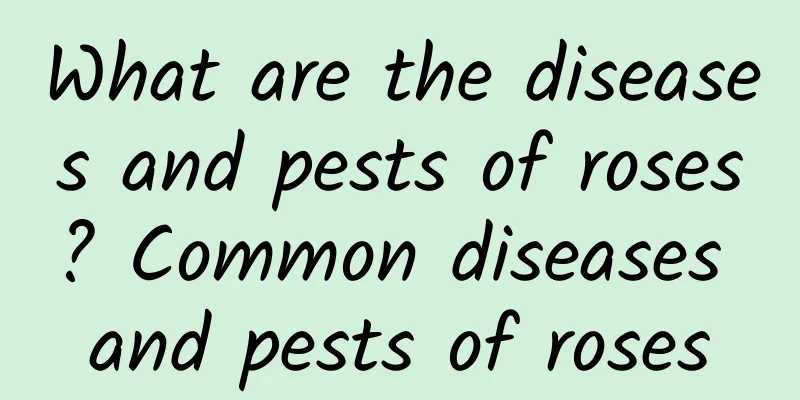What are the diseases and pests of roses? Common diseases and pests of roses

|
Rose is an ornamental plant that many people like, but during the cultivation period, it is often found to have some diseases and insect pests. These diseases and insect pests will not only reduce the ornamental value of roses, but also cause roses to die directly in serious cases. So how should these diseases and insect pests be prevented in normal times? How should they be treated after they occur? The following editor will talk about this issue specifically for you. 1. Rose powdery mildew Powdery mildew is one of the most common diseases of roses. After it occurs, the leaves will fall off, the buds will be deformed or unable to open, and it will directly affect the growth of roses. The best way to prevent this disease is to reduce the source of infection, promptly prune the diseased roses and leaves, and destroy them. In addition, after entering the dormant period, Sibamei should be sprayed to eliminate the overwintering hyphae in the diseased buds, which can effectively reduce the occurrence of powdery mildew in roses. 2. Rose black spot Black spot disease is also one of the most common diseases of roses. After the disease occurs, it mainly manifests itself on the leaves, petioles and oats of roses. In the early stage of the disease, small brown spots will appear on the front of the leaves of roses. As the disease worsens, it will slowly spread into round or irregular spots. The color of the spots is mostly black and purple. To prevent and control this disease, you can completely remove dead branches and leaves in autumn, cut off diseased branches in time and destroy them, and spray pentachlorofen sodium aqueous solution during its dormant period, which can effectively eliminate the overwintering bacteria on roses. 3. Gray mold of rose Gray mold of roses is also a common disease. After it occurs, spots will appear on the flowers, buds and tender stems of roses. In a warm and humid environment, a large amount of gray mold can form at the site of the disease. To prevent gray mold of roses, in autumn, dead leaves cannot be used to protect the roots. When cultivating in a greenhouse, attention should be paid to ventilation to avoid excessive humidity. At the same time, infected flowers and buds should be removed. After gray mold occurs in roses, 75% chlorothalonil wettable powder can be sprayed, and the drug should be used continuously for 2 to 3 times, which can significantly control the disease. |
<<: What are the benefits of planting Wanchongshan
>>: The role and medicinal value of Wanchongshan
Recommend
The efficacy and function of rice vinegar foot bath
Rice vinegar can not only be used for seasoning, ...
How is DFJ Investments? DFJ Investments Review and Website Information
What is Draper Fisher Jurvetson? Draper Fisher Jur...
How to grow crape myrtle in winter? Cultivation methods and precautions for crape myrtle
Many people like crape myrtle and usually grow it...
What is Ballard Power Systems like? Ballard Power Systems reviews and website information
What is the website of Ballard Power Systems? Ball...
Nutritional value of mung bean sprouts
I really love eating bean sprouts, especially mun...
The efficacy and usage of paraffin oil
Paraffin oil is an orange-yellow liquid that is n...
How to make delicious wild amaranth with garlic sauce How to make wild amaranth with garlic sauce
Many people have heard of wild amaranth and know ...
What are the effects and functions of Yin Yang Fruit?
Many people have never heard of Yin Yang Fruit, l...
How to make delicious soybean sprouts
Soybean sprouts are a very common food. Many peop...
Is it good to drink milk before going to bed? The advantages and disadvantages of drinking milk before going to bed
As we all know, milk is a highly nutritious food,...
How to make mushroom porridge
How much do you know about the method of making m...
Barley, Rice and Lentil Porridge
The taste of barley, rice and lentil porridge is ...
What is the Kavli Institute for Theoretical Physics like? Kavli Institute for Theoretical Physics reviews and website information
What is the website of Kavli Institute for Theoret...
The efficacy and function of pepper water foot bath
Sichuan pepper is both a spice and a Chinese medi...
Korean kimchi pickling method diagram
Korean kimchi is the most representative specialt...









